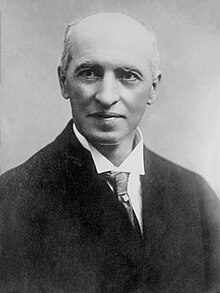Arthur Sifton
|
The Right Honourable Arthur Sifton PC (UK), PC (Can), KC |
|
|---|---|
 |
|
| 2nd Premier of Alberta | |
|
In office May 26, 1910 – October 30, 1917 |
|
| Monarch | George V |
| Lieutenant Governor |
George H. V. Bulyea Robert Brett |
| Preceded by | Alexander Cameron Rutherford |
| Succeeded by | Charles Stewart |
| Alberta provincial treasurer | |
|
In office March 26, 1913 – November 28, 1913 |
|
| Preceded by | Malcolm MacKenzie |
| Succeeded by | Charles R. Mitchell |
|
In office June 1, 1910 – May 4, 1912 |
|
| Preceded by | Alexander Cameron Rutherford |
| Succeeded by | Malcolm MacKenzie |
| Alberta Minister of Public Works | |
|
In office June 1, 1910 – May 4, 1912 |
|
| Preceded by | William Henry Cushing |
| Succeeded by | Charles R. Mitchell |
| Alberta Minister of Railways and Telephones | |
|
In office December 20, 1912 – October 30, 1917 |
|
| Preceded by | Alexander Cameron Rutherford1 |
| Succeeded by | Charles Stewart |
| Canadian Secretary of State | |
|
In office December 31, 1919 – January 21, 1921 |
|
| Preceded by | Martin Burrell |
| Succeeded by | Henry Lumley Drayton |
| Canadian Minister of Public Works | |
|
In office September 3, 1919 – December 30, 1919 |
|
| Preceded by | John Dowsley Reid |
| Succeeded by | John Dowsley Reid |
| Canadian Minister of Customs and Inland Revenue | |
|
In office May 14, 1918 – September 1, 1919 |
|
| Preceded by |
Albert Sévigny (as Minister of Inland Revenue) Continuing (as Minister of Customs) |
| Succeeded by | John Dowsley Reid |
| Canadian Minister of Customs | |
|
In office October 12, 1917 – May 14, 1918 |
|
| Preceded by | John Dowsley Reid |
| Succeeded by | Continuing |
| Northwest Territories Territorial Treasurer | |
|
In office March 1, 1901 – January 14, 1903 |
|
| Preceded by | James Hamilton Ross |
| Succeeded by | Frederick Haultain |
| Northwest Territories Minister of Public Works | |
|
In office March 1, 1901 – January 14, 1903 |
|
| Preceded by | James Hamilton Ross |
| Succeeded by | George Bulyea |
| Member of Parliament for Medicine Hat | |
|
In office December 17, 1917 – January 21, 1921 |
|
| Preceded by | William Ashbury Buchanan |
| Succeeded by | Robert Gardiner |
| Member of the Legislative Assembly of Alberta for Vermilion | |
|
In office June 29, 1910 – October 12, 1917 |
|
| Preceded by | Archibald Campbell |
| Succeeded by | Arthur Ebbett |
| Member of the Legislative Assembly of the Northwest Territories for Banff | |
|
In office June 27, 1899 – January 1903 |
|
| Preceded by | Robert Brett |
| Succeeded by | Charles Wellington Fisher |
| Member of the Brandon City Council | |
|
In office 1882–1884 |
|
| Personal details | |
| Born |
Arthur Lewis Watkins Sifton October 26, 1858 Middlesex County, Canada West |
| Died | January 21, 1921 (aged 62) Ottawa, Ontario |
| Political party | Alberta Liberal Party (1910–1917) |
| Other political affiliations |
Liberal-Conservative (1902–1903) Unionist Party (1917–1921) |
| Spouse(s) | Mary H. Deering |
| Children | 2 |
| Signature | |
| 1 Rutherford served as Minister of Railways until June 1, 1910, after which the position was vacant until Sifton took it. Minister of Telephones was a new position. | |
Arthur Lewis Watkins Sifton, PC (UK), PC (Can), KC (October 26, 1858 – January 21, 1921), was a Canadian politician who served as the second Premier of Alberta from 1910 until 1917. He became a minister in the Government of Canada thereafter. Born in Ontario, he grew up there and in Winnipeg, where he became a lawyer. He subsequently practised law with his brother Clifford Sifton in Brandon, Manitoba, where he was also active in municipal politics. He moved west to Prince Albert in 1885 and to Calgary in 1889. There he was elected to the 4th and 5th North-West Legislative Assemblies; he later served as a minister in the government of Premier Frederick W. A. G. Haultain. In 1903, the federal government, at the instigation of his brother who was now one of its ministers, made Arthur Sifton the Chief Justice of the Northwest Territories. When Alberta was created out of a portion of the Northwest Territories in 1905, Sifton became its first chief justice.
In 1910, the government of Alberta Premier Alexander Cameron Rutherford was embroiled in the Alberta and Great Waterways Railway scandal. The Liberal Lieutenant-Governor of Alberta, George Bulyea, determined that for the sake of the Liberal Party of Alberta, Rutherford had to be pushed aside in favour of a new Premier. When other prominent Liberals declined it, the position was offered to Sifton. As Premier, he smoothed over the divisions in the party that had caused and been exacerbated by the railway scandal. He made attempts to break with the Rutherford railway policy; when these were rebuffed by the courts, he adopted a course similar to Rutherford's. He unsuccessfully pursued the transfer of rights over Alberta's natural resources from the federal government, which had retained them by the terms of Alberta's provincehood.
...
Wikipedia
